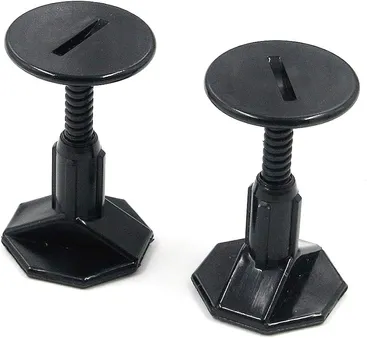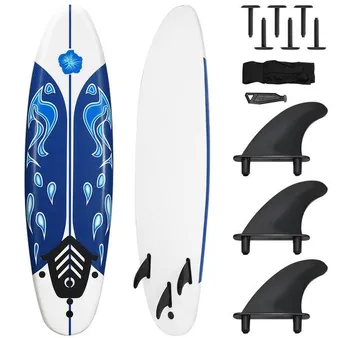Table of Contents
Conquer the waves with The best surfing fins and leashes, your trusted companions for an exhilarating surfing adventure. Whether you're a seasoned pro or a beginner seeking to make a splash, choosing the right equipment is crucial for maximizing performance and ensuring safety. Dive into our comprehensive guide to discover the essential features, benefits, and maintenance tips for selecting the perfect surfing fins and leashes that match your surfing style and skill level. Unlock a world of endless possibilities and elevate your surfing experience with Kizworld, your ultimate source for surfing ise.
The Best Surfing Fins and Leashes: Unveil the Secrets of Surfing Mastery
I. Different Types of Surfing Fins
Different Types of Surfing Fins
Surfing fins are essential pieces of equipment that provide surfers with the necessary control, stability, and propulsion to catch waves and maneuver their surfboards effectively.
There are various types of surfing fins available, each designed to suit different surfing styles, wave conditions, and board shapes. Understanding the different types of fins and their characteristics can help surfers make an informed choice to enhance their surfing performance.
Fin Type | Description | Suitable for |
Single Fin | A single, large fin located in the center of the surfboard. | Longboards, traditional surfboards, and beginner surfers. |
Twin Fins | Two fins placed symmetrically on the rear of the surfboard. | High-performance surfing, fast waves, and experienced surfers. |
Thruster Fins | Three fins, with two smaller fins on the sides and a larger center fin. | All-around surfing, various wave conditions, and intermediate to advanced surfers. |
Quad Fins | Four fins, with two smaller fins on the sides and two larger fins in the center. | Fast waves, powerful turns, and aggressive surfing. |
The size, shape, and flex of the fins also play a significant role in surfing performance.
Generally, larger fins provide more drive and stability, while smaller fins offer increased maneuverability. Stiffer fins are more responsive and provide more control, while softer fins flex more, creating a smoother ride.
Surfers should consider their surfing style, skill level, and the wave conditions they typically surf in when choosing the right fins for their surfboard.
Experimenting with different fin setups can help surfers find the combination that best suits their needs and enhances their surfing experience.
If you're interested in learning more about the different types of surfing fins, check out our article on The Best Surfing Fins and Leashes.
II. Choosing the Right Fins for Your Surfboard
Choosing the Right Fins for Your Surfboard
When selecting fins for your surfboard, consider your skill level, the type of waves you'll be riding, and the board's design. For beginners, larger fins provide more stability and control, while smaller fins offer enhanced maneuverability for experienced surfers.
- Longboards: Typically have single fins or 2+1 setups, providing stability and glide.
- Shortboards: Often use thruster fin setups (three fins) for balance and maneuverability.
- Fish surfboards: Have swallowtail designs and twin fins for loose, playful surfing.
Experiment with different fin configurations to find the optimal setup for your surfing style and conditions.
III. Selecting the Best Leash for Surfing
A surfboard leash is a crucial safety device that keeps you connected to your board. Choose a leash that is the right length for your height and surfing conditions. A longer leash provides more freedom of movement, while a shorter leash offers better control.
Leash Length | Surfer Height | Wave Conditions |
|---|---|---|
6-7 feet | Up to 5'6" | Small to medium waves |
7-8 feet | 5'7" to 6'0" | Medium to large waves |
8-9 feet | 6'1" and above | Large waves and powerful surf |
Look for leashes made from high-quality materials like polyurethane or nylon for durability and reliability.
IV. Essential Features of Surfing Fins and Leashes
- Fins:
- Provide stability, control, and maneuverability.
- Come in various sizes, shapes, and materials.
- Leashes:
- Keep you connected to your surfboard for safety.
- Should be the right length for your height and surfing conditions.
- Made from durable materials like polyurethane or nylon.
Selecting the appropriate fins and leash for your surfing needs is essential for an enjoyable and safe surfing experience.
Ensure your fins and leash are in good condition before each surf session to maximize performance and safety. For more in-depth information on choosing the best surfing fins and leashes, refer to our comprehensive guide The Ultimate Guide to Surfing Fins and Leashes.
V. Benefits of Using High-Quality Surfing Fins and Leashes
Investing in high-quality surfing fins and leashes offers numerous benefits for your surfing experience:
- Enhanced Performance:
- Properly designed fins and leashes improve your surfing performance.
- Increased Safety:
- A reliable leash keeps you connected to your board, reducing the risk of losing it.
- Durability:
- High-quality materials ensure your fins and leash withstand challenging conditions.
By using top-notch fins and leashes, you can surf with confidence, knowing that your equipment is reliable and optimized for your needs.
VI. Tips for Maintaining Surfing Fins and Leashes
Regular maintenance of your surfing fins and leash is crucial to prolong their lifespan and ensure optimal performance:
- Rinse with Fresh Water:
- After each surf session, rinse your fins and leash with fresh water to remove salt and sand.
- Inspect for Damage:
- Regularly check your fins and leash for cracks, tears, or other damage.
- Store Properly:
- Store your fins and leash in a cool, dry place away from direct sunlight.
By following these simple maintenance tips, you can keep your surfing fins and leash in top condition for years to come.
Maintenance Task | Frequency | Benefits |
|---|---|---|
Rinse with fresh water | After every surf session | Removes salt and sand, preventing corrosion and wear. |
Inspect for damage | Regularly, especially after rough surf sessions | Early detection of damage allows for timely repairs, preventing further issues. |
Store properly | When not in use | Protects fins and leash from harsh elements, extending their lifespan. |
VII. The Importance of a Good Leash
The Importance of a Good Leash
When it comes to surfing, a good leash is essential for staying safe in the water. A leash not only keeps you connected to your board, but it also provides a level of security and control that can make all the difference in a dangerous situation.
One of the most important functions of a leash is to prevent you from losing your board in the event of a wipeout. When you fall off your board, a leash will keep it from drifting away, allowing you to easily retrieve it and continue surfing. This is especially important in crowded surf conditions, where there is a greater risk of your board colliding with other surfers or objects in the water.
In addition to preventing lost boards, a leash also provides a level of control that can help you stay safe in the water. If you get caught in a riptide or strong current, a leash can help you stay connected to your board and avoid being swept away. It can also help you maintain your balance and stability when riding waves, reducing the risk of injury.
Benefits of Using a Good Leash
- Prevents lost boards
- Provides a level of control
- Helps you stay safe in the water
- Reduces the risk of injury
When choosing a leash, there are a few things you'll need to consider. The first is the length of the leash. Leashes come in a variety of lengths, from 4 feet to 10 feet. The length of leash you need will depend on your height, weight, and surfing style. A longer leash will give you more freedom of movement, but it can also be more cumbersome. A shorter leash will be easier to manage, but it can also limit your range of motion.
Another thing to consider when choosing a leash is the material. Leashes are typically made from either polyurethane (PU) or thermoplastic polyurethane (TPU). PU leashes are more affordable and durable, but they can also be heavier and less flexible. TPU leashes are lighter and more flexible, but they can also be more expensive.
VIII. Choosing the Right Leash for Your Surfing Style
Choosing the Right Leash for Your Surfing Style
Selecting the right leash for surfing is crucial for safety and performance. Consider these factors when choosing a leash:
- Length: Choose a leash that is long enough to allow you to paddle freely but not so long that it becomes a hindrance.
- Thickness: Thicker leashes are more durable and less likely to break, but they can also be more cumbersome.
- Material: Leashes are typically made from polyurethane or nylon. Polyurethane leashes are more durable, while nylon leashes are more flexible.
- Swivel: A swivel at the leash's attachment point prevents the leash from tangling around your legs.
- Quick-release: Some leashes have a quick-release mechanism that allows you to detach the leash from your board in an emergency.
Once you have considered these factors, you can choose the right leash for your surfing style and needs. Here are some additional tips for choosing a leash:
- If you are a beginner, choose a leash that is longer and thicker than you think you need. This will give you more room to maneuver and will be less likely to break.
- If you are an experienced surfer, you can choose a shorter and thinner leash. This will give you more freedom of movement and will be less likely to get in your way.
- If you surf in waves that are particularly powerful or choppy, choose a leash that is made from a durable material like polyurethane.
- If you surf in waves that are relatively small and mellow, you can choose a leash that is made from a more flexible material like nylon.
No matter what type of leash you choose, make sure that it is in good condition before each surf session. A damaged leash can break and put you at risk.
By following these tips, you can choose the right leash for your surfing style and needs. This will help you stay safe and enjoy your time in the water.
Learn more about the best surfing equipment and accessories
Surfer Height | Leash Length |
Under 5'0" | 6'0" - 7'0" |
5'0" - 5'6" | 7'0" - 8'0" |
5'6" - 6'0" | 8'0" - 9'0" |
6'0" - 6'6" | 9'0" - 10'0" |
Over 6'6" | 10'0" - 11'0" |
Quote: "A good leash is like a good friend - it's always there for you when you need it." - Kelly Slater
IX. Conclusion
As you paddle out into the lineup, remember that the best surfing fins and leashes are those that seamlessly complement your surfing style and skill level. Embrace the journey of exploration and experimentation to find the perfect combination that unlocks your full potential on the waves. With the knowledge gained from this comprehensive guide, you're now equipped to make informed decisions and elevate your surfing experience to new heights. Whether you're riding the waves for the first time or pushing the limits of your abilities, kizworld is your trusted companion, providing you with the ise and resources to navigate the world of surfing with confidence and passion. Embrace the endless possibilities that await you in the realm of surfing, and let the waves carry you to new horizons of exhilaration and fulfillment.